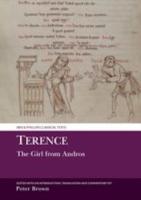
Liverpool (Aris and Phillips) UP (2019) p/b 317pp £24.95 (ISBN 9781789620115)
To our great sadness Peter Brown died on 30th November 2018, before the publication of his Andria.
In standard A&P form, we have a substantial introduction covering Terence’s life, the theatre (material and literary) of his time, a summary of the play, consideration of its relation to Menander’s own Andria, an analysis of its construction, characters and themes, and a detailed discussion of Terence’s idiosyncratic prologues. There is a very interesting section on ‘Interpretation and Metatheatre’ discussing the numerous occasions in Andria when characters either stage some play-acting to fool other characters, or dismiss other characters’ actions as nothing but play-acting. There are short sections on reception and on the differences between Terence’s Latin and that of the classical period. There is a detailed and approachable account of the musical and metrical aspects of the play, a list of differences of reading between this edition and the Oxford text, and a full bibliography. There then follows text with facing translation, commentary and index.
In recent years the Aris and Phillips model has been that the commentary should be keyed almost exclusively to the English translation. It is a great merit of B.’s commentary that he assumes a readership which is going to engage seriously with the Latin text. The lemmata are about 50% Latin/English, and B. does not shy away from detailed discussion of linguistic issues. There is a good deal of discussion of variant manuscript readings, though these come with a health warning in the form of square brackets round the relevant passages.
As we know, all surviving Roman comedies had a Greek ‘original’. The Andria, says Terence, had two, both by Menander: Andria and Perinthia. ‘These two plays were pretty much the same’, says Terence. ‘These two plays were almost entirely different’ says Terence’s ancient commentator Donatus. Donatus also says that two important characters, Charinus and Byrria, ‘do not come in Menander’—without saying where they do come from. This, and the fact that almost nothing survives of these two plays of Menander, has given scholars the opportunity for a huge amount of head-scratching over the relation between Terence and his sources. B. is refreshingly sceptical about all such argument, and always puts the play we have in front of us first.
B. is also particularly enlightening about Terence’s metre, which I have hitherto overlooked as being simply less exciting than Plautus’. He makes it clear that metre and music were carefully used by Terence as a means of bringing out the drama. In this B. relies on the important work of T.J. Moore, without subscribing to Moore’s more fanciful interpretations.
B.’s translation is, as he says, largely identical with his ‘World’s Classics’ version, with some concessions to A&P’s requirement that translation should be not only a self-standing work but also designed to aid the student in working out the Latin grammar. It’s an attractive, fluent translation, and I’m almost convinced when Pamphilus’ remark Eho dum, bone vir, quid ais (616) comes out in fine Wooster mode: ‘I say, my good fellow, look here.’
I have to admit to parti pris in this matter. Peter Brown and I were at Westminster together and owe our enthusiasm for Roman comedy to Theo Zinn and the fine (now sadly defunct) tradition of Westminster Latin Plays. I remember the 1960 production of Adelphoe, where Peter played Bacchis: at the end of the play Fraenkel rose from his place in the audience, saying with deep emotion ‘This is the true Menander’. I am very happy to say that this Andria is an exemplary edition, invaluable for scholars, students and the Latin-inclined general reader alike. A fine work for us to remember Peter by.
Keith Maclennan
